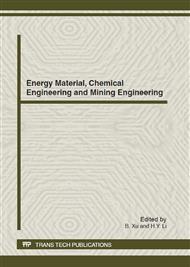p.137
p.142
p.147
p.151
p.155
p.159
p.163
p.167
p.171
Study on the Technique to Control Heat-Damage in Mine
Abstract:
With the increasing of exploitation scope and intensity, the deep mining would be the essential choice, where the heat-harm of high temperature becomes one of the main barriers. Through analyzing the thermal damage feature, the cooling technology were be used that put the mine discharge as cold source to control the heat harm. By disposing three main workstation, the technology can be accomplishes its operations and corresponding functions in different exploitation level. Particularly, the exchanged heat source form the workplace is taken to ground heating by the circulating water which being acted as a carrier. It show that the design concept of this technology include protect the environment and reduce the emission of deleterious air. The results of the project illustrate that the technology to control the heat-harm is efficient. The temperature of the workplace is brought down to 26-29 centigrade, and is 4-6 centigrade lower than the original, and the relative humidity is 5-15﹪ lower than before. It is greatly improves the working environment of the workplace where the heat-harm of high temperature and high humidity lasts for a quite long time. In addition, it extracts deep geothermal energy successful replacing ground fired boiler for heating, further reducing environmental pollution.
Info:
Periodical:
Pages:
155-158
Citation:
Online since:
October 2012
Authors:
Keywords:
Price:
Сopyright:
© 2012 Trans Tech Publications Ltd. All Rights Reserved
Share:
Citation:


